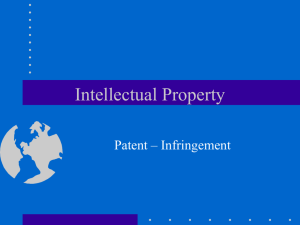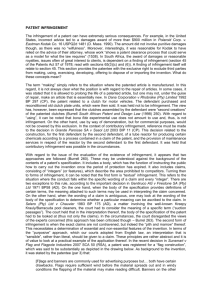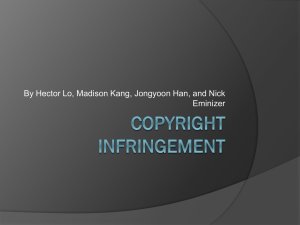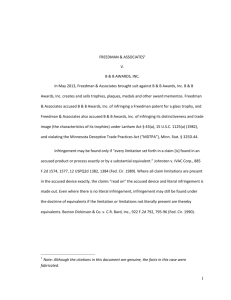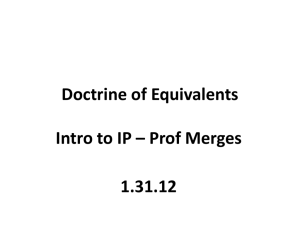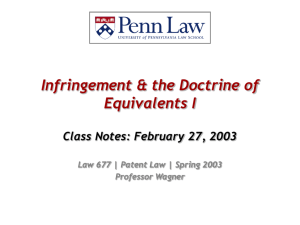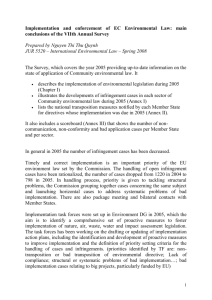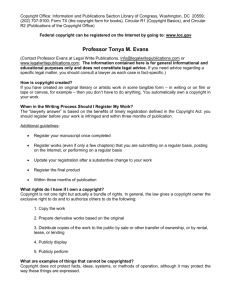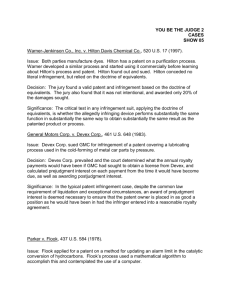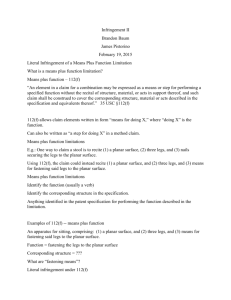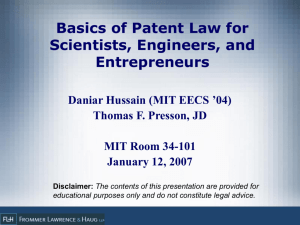basic law for infringement analysis
advertisement
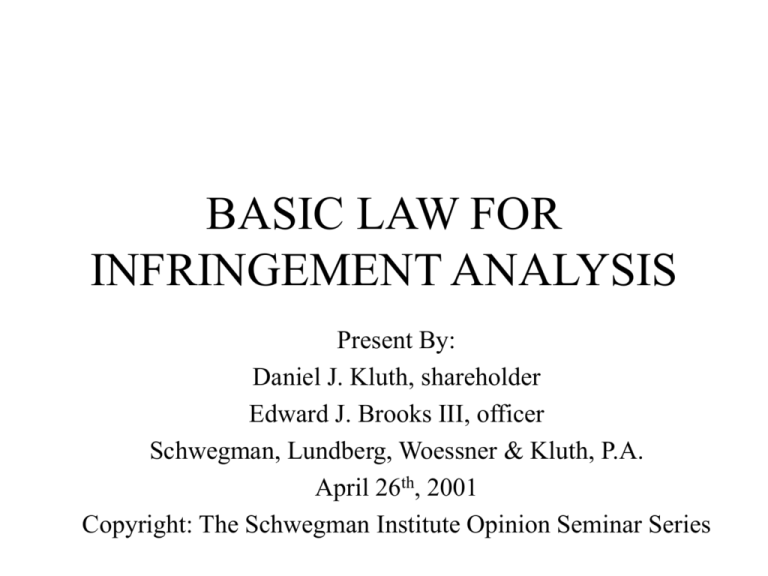
BASIC LAW FOR INFRINGEMENT ANALYSIS Present By: Daniel J. Kluth, shareholder Edward J. Brooks III, officer Schwegman, Lundberg, Woessner & Kluth, P.A. April 26th, 2001 Copyright: The Schwegman Institute Opinion Seminar Series What We’ll Cover/Infringement Analysis • • • • The When/Why/How of Opinions Rules of Claim Construction Literal Infringement Infringement under the Doctrine of Equivalents • Practical Tips for Opinion Practice What We Won’t Cover Today • Validity Analysis • Enforceability Analysis Overview • Determining Infringement is a Two-Step Process – Claim Construction • Determining the Meaning of the claim terms and the scope of the claims – Comparison of the Properly Construed Claims to the Accused Device Who is Asking for an Opinion and Why? • Offensive Purpose – Charge of Infringement – Support a Cease and Desist Letter – Support a Complaint filed in Court • Defensive Purpose – Charged with Infringement – Design Around – Protect Against Willful Infringement • Market Clearance/Due Diligence – Assess the Risk of Liability – Assess the Value of Patent Competent Opinion • • • • • Outside Independent Counsel In Writing List the Facts/Applicable Law Apply the Facts to the Law Timeliness What is the Basis of the Opinion • • • • Alleged Infringed Patent File History of the Patent All Prior Art Cited during Prosecution A reliable description of the Accused Device • Other Possible Evidence • Reliance on Legal Authority/Scientific Principals Liability for the Patent Attorney • Thoroughness • Diligence • Objectiveness Rules of Claim Construction/Markman • Claim Construction as a Matter of Law • Intrinsic Evidence • • • • Claim language Written Description Accompanying Drawings Prosecution History • Extrinsic Evidence • Inventor/Expert Testimony • Treatises/Technical Articles Vitronics/Donaldson/SRI Int’l • Claim terms are to be given their ordinary and customary meaning in the field of invention • When the specification explains and defines a term used in the claims, without ambiguity or incompleteness, stop there • Means Plus Function Claims • Prosecution History Estoppel Mechanics of Claim Construction • Claims Chart – Claims – Specification – File History • Claim Paragraphs • Support in The Specification Literal Infringement Analysis • Applying the Properly Construed Claims to the Accused Product or Process • The question of infringement is a question of fact for a jury • Each and every element must read on the accused device • Each claim stands on its own • Means-Plus-Function claims, the accused device must perform the identical function required by the claim limitation, and must have identical or equivalent structure to that disclosed in the specification Mechanics of Claim Comparison • • • • Claims Comparison Chart Copying Public Notice Ambiguous/Vague Claims Reverse Doctrine of Equivalents • Literal Infringement—The Doctrine in Reverse • Occurs when all the claim elements of an asserted patent are “literally” found in the accused device • May, nevertheless not infringe if the product or process the product or process is so far changed in principle from a patented article that if performs the same or similar function in a substantially different way • One should return to the specification and claim interpretation to clearly articulate the substantiality of these differences Infringement under Doctrine of Equivalents • Equitable Doctrine • Affords protection to inventions where a product avoids the literal language of the claim by making a noncritical change • Each element contained in a patent claim is deemed material to defining the scope of the patented invention • Determine if the differences between the elements of the claimed invention and the suspect infringing device or process are “insubstantial” • Question of Fact Function-Way-Result/Graver Tank • Function-Way-Result Test – Does the non-literally infringing element perform substantially the same function, in substantially the same way, to obtain the same result • All Element Test/Pennwalt – Can an equivalent can be found within the Accused Device for every limitation in the claim • Hypothetical Claim Test/Wilson Sporting Goods Another Approach/Hilton Davis • Substantiality of the Differences • Were elements of the accused and claimed devices were known to be interchangeable at the time of infringement • If the substitute was not known to be interchangeable, would the ordinary artisan would have considered the change insubstantial at the time of infringement/Pennwalt Substantiality of Differences/Timing • Substantiality of the differences is to be based on resolving the question of whether the accused product or process contains elements identical or equivalent to each claimed element of the patented invention • The proper time for evaluating equivalency is at the time of infringement, not at the time the patent issued Other Factors • • • • Copying Design Around Pioneering aspects of the invention Significant Advantage Prior Art/File History Estoppel • Warner Jenkinson/Wilson Sporting Goods/Festo • Limits the range of permissible equivalents is limited by the prior art and the file history • Statements made by the USPTO examiner or the patent applicant which shed some light on the scope of the claims Effect • Prosecution history estoppel precludes a patentee from obtaining coverage of subject matter that has been relinquished during the prosecution • Complete bar to the application of the doctrine of equivalents to any claim elements narrowed during patent prosecution in order to achieve patentability • Presumption that the limitation was added for reasons related to patentability Unsettled Legal Issues • Means-Plus-Function language is interpreted to cover the corresponding structure, material, or acts described in the specification, and the equivalents thereof ??? • Only those equivalents expressly set for in the specification Festo? • Certiorari Granted • Amendments Related to Patentability – changes needed not only to overcome the prior art – Changes needed to overcome indefiniteness rejections • All amendments potentially raise the specter of restricting the applicant’s available protection under the doctrine of equivalents Portfolio IP Presentation given by Tom F. Brennan jkalis@slwk.com
